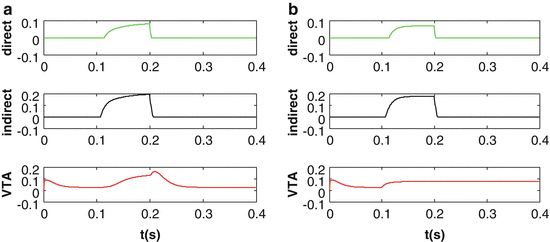Fig. 1
A hippocampal-VTA model
We model the circuit shown in Fig. 1 using mean-field population analysis. Normalized firing rate y i of i-th population is defined by


where x i is neural activity of i-th population, and
 is the total input to the population, and τ i is time constant for activity changes in the population. A hyperbolic function is employed as the output function
is the total input to the population, and τ i is time constant for activity changes in the population. A hyperbolic function is employed as the output function

where ε i is the threshold of population firing rate, which can determine whether a population has a baseline activity. By virtue of the abovementioned method, we model five populations shown in Fig. 1: a population of MSNs with D1Rs that project from NAcc to VTA directly; a population of MSNs with both D1Rs and D2Rs, projecting from NAcc to VP; VP, PPN and VTA populations. The values of connection strength among five populations are chosen following the relevant anatomical features. The feedback dopamine modulation from VTA to NAcc can be described by a coefficient which depends on activity changes in VTA.

(1)

(2)


(3)
3 Results
In order to investigate why expectation of reward in ventral striatum is covert at choice point, we introduce a gate effect of hippocampal theta rhythm on VTA to the proposed population model. When enhanced hippocampal theta rhythm disinhibits VTA, a phasic increase occurs in VTA which responds to input from NAcc. Simultaneously, the feedback dopamine modulation enhanced the NAcc activity (Fig. 2a). In contrast, VTA is inhibited without hippocampal theta rhythm, VTA seldom responds to input from NAcc, so NAcc activity shows no enhanced modulation (Fig. 2b). Comparing Fig. 2a with Fig. 2b, small peak can be observed in NAcc activity when dopaminergic neurons in VTA are disinhibited. This could be the reason why the representation of reward expectation in ventral striatum is covert. Importantly, it is likely that CA3 theta rhythm serves representation of expectation of reward in ventral striatum through gate effect on VTA.









